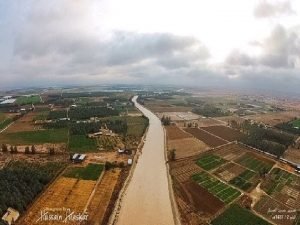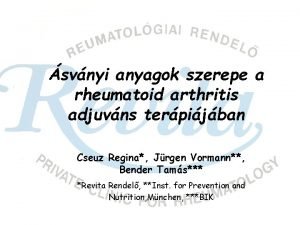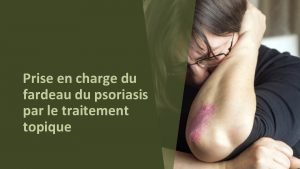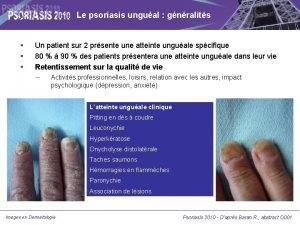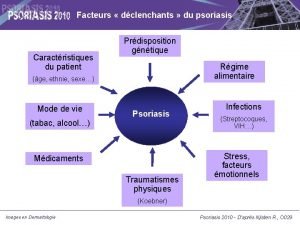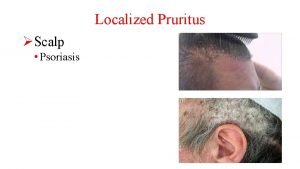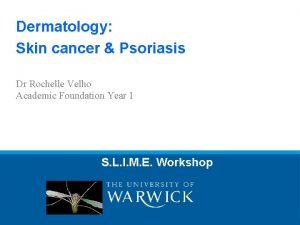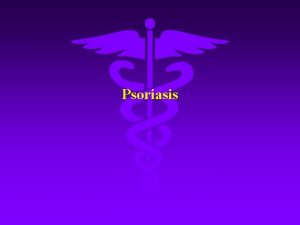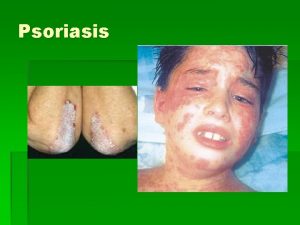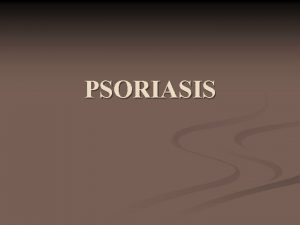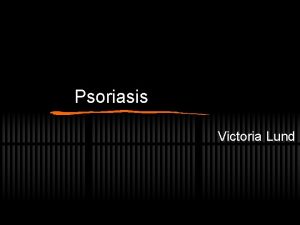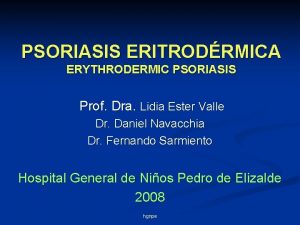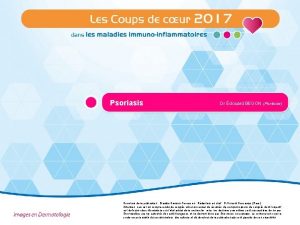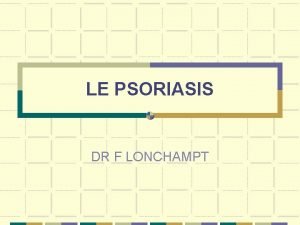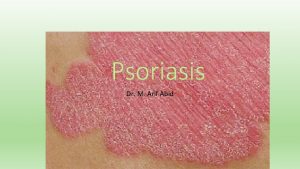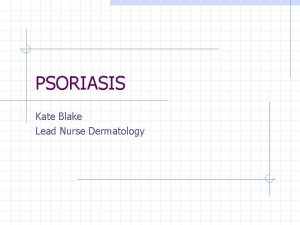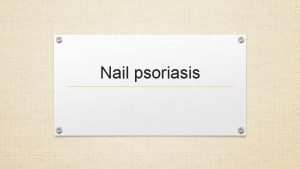Overview Psoriasis is a skin disease that causes














- Slides: 14


● Overview Psoriasis is a skin disease that causes red, itchy scaly patches, most commonly on the knees, elbows, trunk and scalp. Psoriasis is a common, long-term (chronic) disease with no cure. It tends to go through cycles, flaring for a few weeks or months, then subsiding for a while or going into remission. Treatments are available to help you manage symptoms. And you can incorporate lifestyle habits and coping strategies to help you live better with psoriasis. How psoriasis develops In psoriasis, the life cycle of your skin cells greatly accelerates, leading to a buildup of dead cells on the surface of the epidermis.

● Symptoms Psoriasis signs and symptoms can vary from person to person. Common signs and symptoms include: Red patches of skin covered with thick, silvery scales Small scaling spots (commonly seen in children) Dry, cracked skin that may bleed or itch Itching, burning or soreness Thickened, pitted or ridged nails Swollen and stiff joints Psoriasis patches can range from a few spots of dandruff-like scaling to major eruptions that cover large areas. The most commonly affected areas are the lower back, elbows, knees, legs, soles of the feet, scalp, face and palms. Most types of psoriasis go through cycles, flaring for a few weeks or months, then subsiding for a time or even going into remission.

There are several types of psoriasis, including: Plaque psoriasis. The most common form, plaque psoriasis causes dry, raised, red skin patches (lesions) covered with silvery scales. The plaques might be itchy or tender, and there may be few or many. They usually appear on elbows, knees, lower back and scalp. Plaque psoriasis Nail psoriasis. Psoriasis can affect fingernails and toenails, causing pitting, abnormal nail growth and discoloration. Psoriatic nails might loosen and separate from the nail bed (onycholysis). Severe cases may cause the nail to crumble. Nail psoriasis

Guttate psoriasis Guttate psoriasis. This type primarily affects young adults and children. It's usually triggered by a bacterial infection such as strep throat. It's marked by small, drop-shaped, scaling lesions on the trunk, arms or legs. Inverse psoriasis. This mainly affects the skin folds of the groin, buttocks and breasts. Inverse psoriasis causes smooth patches of red skin that worsen with friction and sweating. Fungal infections may trigger this type of psoriasis. Inverse psoriasis Pustular psoriasis. This rare form of psoriasis causes clearly defined pus-filled lesions that occur in widespread patches (generalized pustular psoriasis) or in smaller areas on the palms of the hands or the soles of the feet.

Erythrodermic psoriasis. The least common type of psoriasis, erythrodermic psoriasis can cover your entire body with a red, peeling rash that can itch or burn intensely. Erythrodermic psoriasis Psoriatic arthritis causes swollen, painful joints that are typical of arthritis. Sometimes the joint symptoms are the first or only symptom or sign of psoriasis. And at times only nail changes are seen. Symptoms range from mild to severe, and psoriatic arthritis can affect any joint. It can cause stiffness and progressive joint damage that in the most serious cases may lead to permanent joint damage.

● Causes Psoriasis is thought to be an immune system problem that causes the skin to regenerate at faster than normal rates. In the most common type of psoriasis, known as plaque psoriasis, this rapid turnover of cells results in scales and red patches. Just what causes the immune system to malfunction isn't entirely clear. Researchers believe both genetics and environmental factors play a role. The condition is not contagious. ● Psoriasis triggers Many people who are predisposed to psoriasis may be free of symptoms for years until the disease is triggered by some environmental factor. Common psoriasis triggers include: Infections, such as strep throat or skin infections Weather, especially cold, dry conditions Injury to the skin, such as a cut or scrape, a bug bite, or a severe sunburn Stress Smoking and exposure to secondhand smoke Heavy alcohol consumption Certain medications — including lithium, high blood pressure medications and antimalarial drugs Rapid withdrawal of oral or systemic corticosteroids

● Risk factors Anyone can develop psoriasis. About a third of instances begin in the pediatric years. These factors can increase your risk: Family history. The condition runs in families. Having one parent with psoriasis increases your risk of getting the disease, and having two parents with psoriasis increases your risk even more. Stress. Because stress can impact your immune system, high stress levels may increase your risk of psoriasis. Smoking tobacco not only increases your risk of psoriasis but also may increase the severity of the disease. Smoking may also play a role in the initial development of the disease.

● other pathogenesis associated to psoriasis which includes…. If you have psoriasis, you're at greater risk of developing other conditions, including: • Psoriatic arthritis, which causes pain, stiffness and swelling in and around the joints • Eye conditions, such as conjunctivitis, blepharitis and uveitis • Obesity • Type 2 diabetes • High blood pressure • Cardiovascular disease • Other autoimmune diseases, such as celiac disease, sclerosis and the inflammatory bowel disease called Crohn's disease • Mental health conditions, such as low self-esteem and depression

Homeopathic therapeutics The main remedies for Psoriasis are Arsenic Album, Graphites Naturalis, and Arsenic Iodatum. The main indicating features for these homeopathic medicines are as follows: 1. Arsenic Album –For Silver Scales The chief indicator for using Arsenic Album is the presence of dry, rough, red papular eruptions with scales on it. The scales are silver colored. The eruptions cover most parts of the body, except face and hands. The eruptions spread rapidly and are accompanied by itching. Cold worsens the itching in most cases, while warmth seems to relieve it. Pain on the affected skin arises after scratching the eruptions. Bleeding spots also appear on the skin following scratching. Restlessness is another symptom that may be present. Yet another symptom is marked anxiety that accompanies itchy eruptions. Arsenic Album also works well in cases of guttate Psoriasis. In guttate Psoriasis, small rose coloured spots with scales appear.

2. Graphites Naturalis – For Cracked Skin Cases where Graphites Naturalis works well tend to have patches of sore, dry, rough skin with scales. An inclination to develop cracks on the surface may also be there. Following scratching, stickiness on the skin may appear. Graphites Naturalis is also useful for cases of scalp Psoriasis. In such cases, eruptions with scales appear on the scalp. The scalp may be sore to touch, with distressing itching. One may also feel a burning sensation on the top of the head. Eruptions on the scalp can also spread behind the ears. In cases of nail Psoriasis, the characteristic features are rough, thick and deformed nails. 3. Arsenic Iodatum – For Shedding of Large Scales Arsenic Iodatum is used when there is shedding of large scales from the skin eruptions. The skin is covered with inflamed patches with scales on them. There is persistent itching in the patches and the shedding of the scales leaves raw skin behind.

4. Sulphur – For Intense Itching and Burning Sulphur helps in cases with severe itching and burning in the psoriatic skin lesions. A violent itching attends, and the person goes on scratching the skin until it bleeds. A burning sensation follows scratching. The itching is wandering, and changes place frequently. The skin is rough, scaly and gets painful after rubbing as if denuded. The symptoms tend to get worse in the evening and at night, when in bed. Sleep is disturbed because of the itching and burning sensation. Other accompanying symptoms are pricking, biting and sticking sensation in the eruptions. Sulphur is also a remedy for skin ailments with a history of excessive use of ointments in the past. 5. Petroleum Oleum – For Deep Cracks Petroleum Oleum is a very suitable remedy for Psoriasis where deep cracks appear on the skin. There is a burning sensation and intolerable itching on the affected skin. Bleeding may also be present in the cracks. The skin is intensely sore, painful, hard, fissured and slow to heal. A crawling sensation on the skin may also attend over and above the given symptoms.

6. Sepia Succus – For Large Oval Lesions Sepia Succus is a beneficial medicine for Psoriasis characterised by the presence of big oval lesions on the skin. The lesions are reddish papules and are isolated. There are shiny, whitish and adhesive scales present on the papules. Itching arises in the eruptions. On scratching, a burning sensation on the skin follows. The eruptions are present over the face, chest, back, arms and legs. In the case of limbs, the extensor surfaces are mostly involved. 7. Merc Sol – For Scalp Psoriasis Merc Sol is a medicine for Psoriasis of the scalp. In typical cases, the scalp is covered with abundant white scales. The base underneath the scales is raw. The scales, which shed rapidly, re-form again and again. An intense itching, which is worse at night, accompanies. The skin of the scalp is also sensitive to touch. An excessive sweat (which may be sour smelling) may also be present on the scalp. Hairfall may also appear in few cases along with above symptoms.

Thank you Presented by : Rathod Dhwani Brijeshbhai Student of Final year BHMS Ahmedabad Homeopathic Medical College Under guidance : Dr. Vani chaag Lecturer In department of Practice of medicine
 Grattage test in psoriasis
Grattage test in psoriasis Morphea gyulladásos fázisa
Morphea gyulladásos fázisa Psoriasis
Psoriasis Psoriasis arthritis nhs
Psoriasis arthritis nhs Physiopathologie psoriasis
Physiopathologie psoriasis Psoriasis ungual
Psoriasis ungual Rehaklinik psoriasis arthritis
Rehaklinik psoriasis arthritis Mild scalp psoriasis pictures
Mild scalp psoriasis pictures Anatomy and physiology of psoriasis
Anatomy and physiology of psoriasis Abc of skin cancer
Abc of skin cancer Sepical meaning
Sepical meaning Thơ thất ngôn tứ tuyệt đường luật
Thơ thất ngôn tứ tuyệt đường luật Tôn thất thuyết là ai
Tôn thất thuyết là ai Walmart thất bại ở nhật
Walmart thất bại ở nhật Thơ thất ngôn tứ tuyệt đường luật
Thơ thất ngôn tứ tuyệt đường luật


